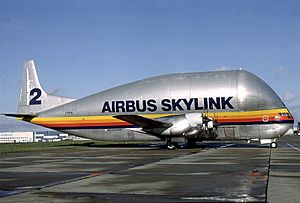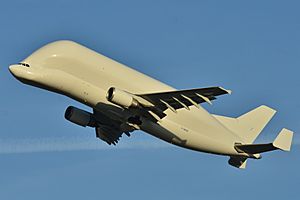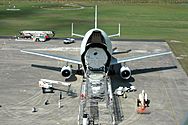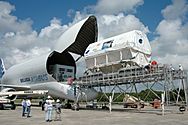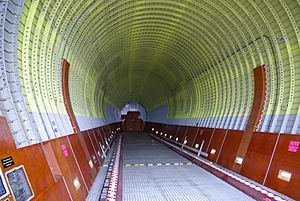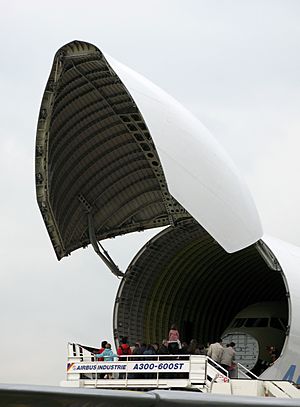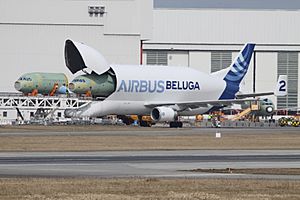Airbus Beluga facts for kids
Quick facts for kids A300-600ST Beluga |
|
|---|---|
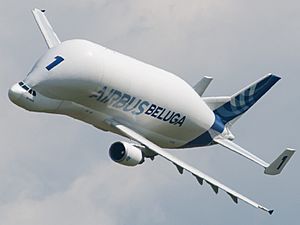 |
|
| The Beluga is based on the Airbus A300 with an oversized cargo hold on top | |
| Role | Outsize cargo freight aircraft |
| Manufacturer | Airbus |
| First flight | 13 September 1994 |
| Introduction | September 1995 |
| Status | In service |
| Primary user | Airbus Transport International |
| Produced | 1992–c.1999 |
| Number built | 5 |
| Developed from | Airbus A300-600 |
| Developed into | Airbus Beluga XL |
The Airbus A300-600ST, also known as the Super Transporter or simply Beluga, is a special wide-body aircraft. It is used to carry very large airplane parts and other huge items. People started calling it "Beluga" because it looks a lot like a Beluga whale. This nickname became so popular that it is now its official name!
Airbus, the company that makes these planes, has factories in many different countries. They needed a way to move big parts like wings and fuselage sections (the main body of the plane) to their final assembly lines. Before the Beluga, they used older planes called "Super Guppies." These planes were getting old and expensive to keep flying.
So, Airbus decided to build a new, bigger plane. They chose to base it on their existing Airbus A300 aircraft. The first Beluga flew on September 13, 1994, and started working in September 1995. It was much bigger, faster, and more efficient than the old Super Guppies. Airbus built five of these amazing planes.
Besides carrying Airbus parts, the Belugas sometimes fly special missions for other customers. They have carried everything from helicopters to industrial machines and even aid for people in need. In 2022, Airbus even started a service to offer the Beluga for hire to transport huge cargo for other companies.
Airbus later developed an even bigger plane, the Airbus Beluga XL, based on the Airbus A330-200. This new fleet started flying in 2020 and will eventually take over from the original Belugas. However, all the original Belugas are still flying today!
Contents
Why was the Beluga created?
Moving Airplane Parts Across Europe
Many large aircraft manufacturers have factories in different places. Airbus is special because it started as a group of companies from Britain, France, Germany, and Spain. Even today, different parts of an Airbus plane are made in different countries.
For example, the wings and landing gear might be made in the UK. The tail and doors come from Spain. The main body (fuselage) is made in Germany, and the nose and middle section come from France. Then, all these parts are flown to a central place like Toulouse, France, or Hamburg, Germany, for final assembly.
When Airbus first started in 1970, they used trucks to move parts. But as they made more planes, they needed to use airplanes. From 1972, they used four special planes called "Super Guppies." These were old 1940s planes that had been changed to carry very large items. People even joked that "every Airbus is delivered on the wings of a Boeing" because the Super Guppies were originally Boeing planes!
Over time, the Super Guppies became too old and expensive to operate. Airbus needed a new solution. They looked at different ways to transport parts, like by road, train, or sea. But these methods were too slow and unreliable. Also, the assembly line in Toulouse was hard to reach by land or sea.
Finding the Right Plane
Airbus needed a new plane that could carry every major part they made, including the large wings of the Airbus A340. They also needed the new plane quickly.
They looked at many existing large planes, such as the Antonov An-124, Boeing 747, and Lockheed C-5 Galaxy. However, none of these planes had enough internal space for the huge parts. Boeing offered to change some of its 767 planes, but Airbus decided it would be better to build a new plane based on their own Airbus A300-600R.
In 1991, two main Airbus partners, Aérospatiale and DASA, created a joint company called Super Airbus Transport International (SATIC). Their goal was to develop a new plane to replace the Super Guppies. They chose the Airbus A300 as the starting point, and the new plane was named the A300-600ST Super Transporter.
The A300-600ST was designed to be much bigger, faster, and more efficient than the Super Guppies. Airbus invested $1 billion in this project, which included building the planes and creating a new system for loading cargo.
How the Beluga entered service
Building the first Beluga started in September 1992. It made its first flight in September 1994. After many test flights, the plane was approved to fly in October 1995. Soon after, the A300-600ST "Beluga" began its service.
Airbus built four more Belugas, making a total of five. Each plane took about three years to complete. The main job of these planes is to carry Airbus parts across Europe. They fly about 60 times a week between Toulouse, Hamburg, and other sites.
The Beluga fleet is owned by Airbus Transport International (ATI), a company created just to operate these planes. ATI also rents out the Belugas for special flights when they are not busy with Airbus parts. The Beluga has carried many unusual loads, such as parts for the International Space Station, large pieces of art, industrial machines, and even whole helicopters.
The cargo area of the A300-600ST is 7.4 m (24 ft) (about 24 feet) wide and 37.7 m (124 ft) (about 124 feet) long. It can carry a maximum of 47 tonnes (about 103,600 pounds) of cargo.
In 2014, Airbus announced they would build a larger replacement for the Beluga, based on the Airbus A330-200. This new plane, called the Airbus BelugaXL, started flying in 2020. It is designed to carry even bigger parts, like two wings for the Airbus A350 at the same time. The BelugaXL will slowly replace the original Beluga fleet.
How the Beluga is designed
The A300-600ST Beluga looks very different from a regular Airbus A300, but it shares many parts with it. The wings, engines, landing gear, and the lower part of the body are the same as on a normal A300. However, the upper part of the fuselage is a huge, horseshoe-shaped structure, 7.7 m (25 ft) (about 25 feet) wide.
Compared to the old Super Guppy, the Beluga can carry more than twice the weight and has over 30% more space. Its engines are slightly more powerful than those on a standard A300. The tail of the Beluga was also changed and made stronger to help with stability.
One clever design feature is that the cockpit (where the pilots sit) was moved down, below the cargo floor. This means that to load cargo, workers don't have to disconnect all the electrical and hydraulic systems. This change cut loading times in half compared to the Super Guppy. The Beluga also has a special loading system that allows cargo to be rolled on and off quickly, even in windy conditions. These improvements made transporting Airbus parts much cheaper.
The cockpit of the Beluga is pressurized, meaning it has normal air pressure like a passenger plane. But the cargo area is not pressurized. This means people cannot go into the cargo area during flight, and it's not suitable for things that need pressure, like live animals. However, the cargo area has a heating system to keep things at the right temperature.
The Beluga's main cargo area is larger than that of the C-5 Galaxy or the Antonov An-124. However, it can only carry up to 47 tonnes (about 103,600 pounds) of weight. This is less than the C-5 Galaxy (122.5 tonnes) or the An-124 (150 tonnes). Even with its wide body, the Beluga cannot carry most parts of the huge Airbus A380 plane. Those parts are usually moved by ship and road.
Beluga's Missions and History
In January 1996, the Beluga officially started its main job: flying parts to the final assembly lines in Toulouse, France, and Hamburg, Germany. By October 1997, the old Super Guppy planes were retired, and the Beluga fleet took over all the large cargo missions. In its second year, the Beluga fleet flew over 2,500 hours on more than 1,400 flights.
Over the years, airports that the Belugas visit often have been improved. For example, in 2011, Pau Pyrénées Airport became the first airport in Europe to use a special navigation system that helps the Beluga land accurately. In 2015, a special loading station was built at Hawarden Airport to protect operations from strong winds.
Besides its regular duties for Airbus, the Beluga often performs special flights for other customers. In 1997, the company operating the Belugas had to turn down many requests for commercial flights because the planes were so busy. But as more Belugas were built, they had more time for these special missions. Even Boeing, a rival aircraft company, has chartered Beluga flights!
In June 1997, a Beluga set a world record for carrying the largest volume of cargo. It transported a huge chemical tank for a ship from Clermont-Ferrand to Le Havre, France. In 2003, a Beluga flew for 25 hours (with stops for fuel) to carry two NHI NH90 helicopters and one Eurocopter Tiger helicopter from France to Australia for an airshow.
In 1999, a Beluga carried a famous painting called Liberty Leading the People by Eugène Delacroix. This painting, which usually hangs in the Louvre museum in Paris, was too big to fit into a Boeing 747. The Beluga flew it from Paris to Tokyo in about 20 hours. The painting was placed in a special pressurized container that protected it from temperature changes and vibrations.
The Beluga has also been used for humanitarian missions. In 2004, it delivered relief supplies to the Indian Ocean region after a major tsunami. In 2005, it carried aid from the United Kingdom and France to the Gulf Coast of the United States after Hurricane Katrina.
The Beluga is often used to transport large items for space exploration programs. In 2001, parts of the unmanned Automated Transfer Vehicle (ATV) space vehicle were flown by a Beluga from Italy to the Netherlands. In 2009, a Beluga carried the Tranquility module of the International Space Station from Italy to the Kennedy Space Center in the United States.
In 2019, a new two-bay loading dock was opened in Toulouse. This helps the Belugas turn around faster, in about one hour and 20 minutes, down from two hours and 30 minutes. This new dock also protects the loading process from bad weather.
In 2022, Airbus started offering its BelugaST fleet for hire to transport large cargo for other companies. This service saw more demand after changes in global transport needs affected other large cargo services. Airbus expects to perform over 150 such flights each year. In September 2022, Airbus began testing a new loading system for military cargo with the BelugaST fleet. They successfully loaded a Sikorsky CH-53 Sea Stallion military helicopter into a Beluga for the German armed forces.
Specifications (A300-600ST)
Data from Airbus, Airbus: Beluga
General characteristics
- Crew: 2
- Capacity: 47,000 kg (103,617 lb) typical load
- Length: 56.15 m (184 ft 3 in)
- Wingspan: 44.84 m (147 ft 1 in)
- Height: 17.24 m (56 ft 7 in)
- Wing area: 260 m2 (2,800 sq ft)
- Empty weight: 86,500 kg (190,700 lb)
- Max takeoff weight: 155,000 kg (341,717 lb)
- Fuel capacity: 23,860 L (6,303 US gal)
- Fuselage external diameter: 7.31 m (24 ft) (including lower fuselage)
- Cargo cross-section diameter: 7.1 m (23 ft 4 in) in cargo compartment
- Cargo hold – volume 1,500 m3 (53,000 cu ft), 37.7 m (124 ft) long × 7.04 m (23.1 ft) wide × 7.08 m (23.2 ft) tall
- Powerplant: 2 × General Electric CF6-80C2A8 turbofan, 257 kN (58,000 lbf) thrust each
Performance
- Maximum speed: Mach 0.7 Maximum Operating Mach – MMO
- Range: 2,779 km (1,727 mi; 1,501 nmi) with 40 t (88,000 lb) payload - 4,632 km (2,501 nmi) with 26 t (57,000 lb) payload
- Service ceiling: 10,668 m (35,000 ft)
See also
 In Spanish: Airbus A300-600ST Beluga para niños
In Spanish: Airbus A300-600ST Beluga para niños
- List of civil aircraft
- Aircraft related to this one
- Airbus A300
- Airbus Beluga XL
- Similar aircraft
- Aero Spacelines Pregnant Guppy
- Aero Spacelines Super Guppy
- Antonov An-124 Ruslan
- Antonov An-225 Mriya
- Boeing Dreamlifter


